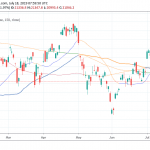- The Nikkei 225 closing at its lowest level since December 2018 today, below 19,500.00, could be enough to convince the BOJ to ease in its upcoming meeting.
In today’s market brief, I mentioned that the Nikkei 225 sustained another significant loss as risk aversion dominated trading. It finished 2.27% or 450.91 points in the red at 19,415.99 as coronavirus concerns once again haunted investors. However, more than the Nikkei 225 closing at its lowest level since December 2018, the stock index falling below 19,500.00 becomes problematic for the BOJ.
A Brief History of the BOJ’s Monetary Policy
Japan has had a decades-long problem with deflation. When BOJ Governor Kuroda stepped in as central bank head in 2013, he implemented buying ETFs (Exchange-Traded Funds) as part of the BOJ’s asset program. This, along with ultra-low rates, aimed to provide the economy with ample liquidity. The hope was for banks to loan out more and for consumers to spend the cash in the Japanese economy.
The BOJ’s ETF-buying has grown drastically over the years. It was initially pegged at 1 trillion yen and was subsequently raised to 3 trillion. In 2016, it was adjusted to where it is now at 6 trillion yen annually.
Why Is the Nikkei 225 Closing Below 19,500.00 Significant?
In a parliamentary statement, BOJ Governor Kuroda said that the cost of the central bank’s ETF purchases is around 19,500.00 on the Nikkei 225. This means that for as long as the stock index is below this price, the central bank is incurring a massive paper loss. It is true that the central bank will not actually realize its losses until it sells, however, it can’t be denied that the Nikkei 225’s weakness poses a huge risk to the BOJ.
Therefore, it is widely-expected that the central bank would announce additional easing when it meets on March 18 to 19. Its interest rates are at -0.10% and are already hurting the profitability of banks. With this, it is expected that the BOJ would increase its asset purchases even more and inject more liquidity in the stock market and economy.
Read our Best Trading Ideas for 2020.
Nikkei 225 Outlook
On the monthly chart, it appears that a double top chart pattern has materialized. This is characterized by a market getting rejected at a resistance level twice. For the Nikkei 225, that price was the 24,000.00 handle. In technical analysis, this is considered as a bearish reversal pattern. A strong bearish close below its neckline at 18,948.58 could mean that the stock index could soon fall to the area around the 100 SMA at 17,454.40. This price also coincides with its July 2007 highs. If support there does not hold, the next floor could be at 15,000.00 where the index bottomed in 2016.
The question is, will the BOJ let the Nikkei 225 fall any further? If it intervenes, we could see the stock index rally to its April 2019 highs at 22,190.00.





